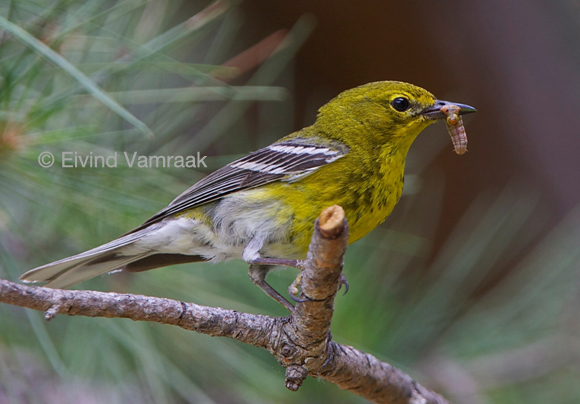
For a change of pace, this month I would like to talk about a nemesis bird—one that keeps getting away. Scattered records in central Oklahoma suggest that the Pine Warbler (Dendroica pinus) should show up one of these years on the Oklahoma City Christmas Bird Count (CBC), but it always seems to remain just out of reach. Mark Howery, Non-game Biologist at the Oklahoma Department of Wildlife Conservation, says that “Yes I had two Pine Warblers one year on the Arcadia CBC and we’ve had Pine Warblers either on count day or during count week at least five of the past ten years on the Norman CBC.” One winter I photographed one in the backyard of a Norman resident; Dr. George Sutton had alerted me to the bird’s presence. And even far north of us, Sutton (Oklahoma Birds, 1967), reported a winter record of “…8 seen on January 1, 1966…in a cemetery in Manhattan,” northcentral Kansas.
Here inside the Oklahoma City CBC area, Warren Harden, on a CBC several years ago, saw a 2-wing bar, buffy breasted, warbler that possibly was a 1st winter Pine Warbler; it was below the Lake Overholser dam south of NW 10th Street: 1st winter plumaged birds can be particularly difficult to identify. Quite a number of years ago I heard a suspicious call (either on count day or slightly before) in the top of a very large pine, typical habitat for the Pine Warbler. But I never could see the singer and had to pass on an ID, because a Pine Warbler’s song is too similar to that of a Dark-eyed Junco or Chipping Sparrow. Like I say, this is a nemesis bird for the OK City Count—so close, but never YES!
Something of a surprise to me was to learn that Pine Warblers aren’t overly attached to pine trees. A. C. Bent (1963 reprint of Life Histories of North American Wood Warblers, part two) reports that N. S. Goss, in an 1891 article, stated that “in Kansas during the winter months, ‘they seem to be as much at home in the deciduous trees as among the pines, often visiting the orchards and lowland thickets.’”
According to Ken Kaufman (Birds of North America, 2000), Pine Warbler adults are “olive above, yellow on chest, with two wing-bars; males have blurry streaks on chest, females plainer.” Kaufman goes on to say that the song is a “rich musical trill on one pitch;” the song can be quite helpful in identifying the bird. Just don’t forget that the Dark-eyed Junco and the Chipping Sparrow also have similar songs.
The reason I got to thinking about Pine Warblers is that Bill Diffin was telling Warren Harden and me about a Pine Warbler that he and other participants had seen on a field trip to Lake Arcadia on 13 November 2010; the bird was on a peninsula that extended into the lake. The beautiful photograph of this very bird was taken and graciously provided by Eivind Vamraak. As Bill, Warren and I were talking about this bird, the subject of what such a Pine Warbler might eat came up and none of us could say much for sure. Bent (1963) says that A. H. Howell, in a 1932 article reported that 7 stomachs examined of Pine Warblers taken in Florida “showed the food to consist largely of insects and spiders, with small quantities of vegetable debris.” Again, examine Eivind’s photo, and note what is in the bird’s bill! Bent (1963) goes on to note that this warbler is an “excellent fly-catcher, but in winter…it feeds largely on vegetable food, mainly the seeds of the various pines, but also on wild fruits and berries…”
This newsletter probably will not be read by most of you until after this year’s CBC, but remember, in our CBC report we can mention species seen during count week, 3 days before and 3 days after count day. So if we do not see one on count day, maybe someone can brush up quickly on identifying points, including song, then carefully check out any large grove of pine you know about, but remember also that the bird might show up in deciduous trees, well away from pines. Otherwise, we will just have to say, “Maybe next year!”
